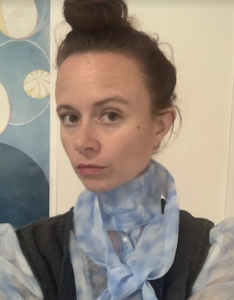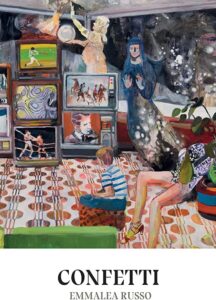
I came to Emmalea Russo’s work not through the usual literary channels, but through hearing her hold forth on poetry as “thing” on the eclectic arts podcast, Contain. Russo’s Confetti leans into its own thing-ness, a resistance to the quick delivery of meaning (to paraphrase Byung-Chul Han). In Confetti, cinema, geometry, philosophy, and literature mel(t)(d) like plastics, to bombastically disorienting effect. Yet there is also restraint and border, line and ligament.
In the following interview, Russo responds to a few of my curiosities about Confetti as well as her overarching artistic vision and process.
Stephanie Yue Duhem: Confetti is highly experimental in the way it blurs poetry, film, and philosophy—drawing on influences from Artaud and Bataille to The Texas Chainsaw Massacre and Deleuze. I have to admit I was pretty perplexed when I first started reading it. But a dozen poems in, a weird synesthetic sensation overtook me.
It felt like I was chewing a pen cap and tasting the plastic on my tongue—there was a discomfort associated with the melding of manufactured and organic material.
I wonder if you yourself have had analogous experiences during the writing of these poems, or in reading/watching work which has influenced you. Also, I wonder if other readers have reported similar reactions.
Emmalea Russo: You know the feeling of finishing a popsicle: teeth scraping the stick as you lick the last of the cold sweet stuff? Years ago, someone told me that my work gave her that sensation. That immediately sprung to mind when you told me you felt as if you were chewing on a pen cap and tasting plastic on your tongue while reading Confetti. Weird!

On its surface, poetry is perplexing, right? When it’s working, it stirs another form of understanding under/around the words. Beyond getting it or not getting it. That’s what I like about it. Do those agitations and commotions, big or little, mean it’s working on an alchemical level? Both the pen cap and the popsicle have to do with taste and texture: psychoactive admixtures that are peculiar and discomforting. Both are also totally ordinary, which makes me happy. I’m not a pen cap–chewer, but guess it happens during a lapse which might be engined by boredom, anxiety, intense focus, or zoning out. When you first wrote to me, I think you said that the plastic pen cap sensation was semi-pleasant, or at least disquieting enough to make you stick with the book despite an initial huh? A chewy suspension.
Mouths are omnipresent in Confetti—kissing, sucking, chewing, salivating, feasting, fasting. What does the mouth do when we’re thinking, reading poetry, watching or approaching a lover or an enemy, a horror movie or a romcom? I’m curious.
I write around two movies in Confetti, The Texas Chainsaw Massacre and Trouble Every Day, which deal with cannibalism as a site for horror and desire. Simone Weil, who appears a lot in the book, wrote that we mostly love and live like cannibals. How do we house the other? How to not eat/destroy/digest the other? She creates an ethics of hospitality around looking and eating. Georges Bataille, another eye-obsessed Confetti guide, wrote that a kiss is the beginning of cannibalism. This intersection between the material world and the apparently transcendent is unresolved and unsolvable except in the beyond where, Simone Weil says, looking and eating are no longer separate. We’ll see.
It’s the age-old problem of merging! When we see something/one beautiful, we want to consume it. To consume it is to alter. I guess Confetti deals with this tension, which is also a question of distance and proximity and the sliding scale between love and violence, desiring and consuming, in terms of cinema, light, horror, eating, and screens. Am I overthinking the pen cap question?
Throughout the poems and the visual diagrams in Confetti (as well as the film stills they are based on, which you have published on your website), I noticed the recurring motifs of: suns, eyes, beams/lines of light, and spotlights. Can you talk more about what draws you to these symbols? Do they harbor specific resonances for you that are expressible in prose? When did you start to be drawn to them, and how might their meanings have changed over time for you?
Eyes and suns, yes. Highs and lows. A wide-open eye taking up the entire frame is a stock horror image. The sun is a symbol of eternity. As a material, confetti gets lobbed up high in celebration and then falls down to the ground to mix with trash, melt, get swept up. We can think about horror, like ecstatic moments of celebration or romantic fusion, as too much or not enough light. The eye open and vulnerable, exposed. Loss of sight, bedazzlement, derangement, occurs.
Ancient astrology is a simple and complicated language of light and lines of sight—how planets see each other or not. How planets get renewed, overwhelmed, and excited by their proximity to the sun. In Confetti, screens are everywhere. There’s a too-much-ness, an overload of light sources and information. Simultaneously, I attempt to find order by turning to sunrise and sunset: those originary events, bookends, beginning-end.
And yeah, the book has several visual diagrams based on screen shots from the films I’m referencing, which tend to perplex! But they can be simply looked at and felt. Diagrams are simplified drawings, geometric figures. The diagrams in Confetti, like star charts, map light. I think of the diagrams as playful and so serious, a concoction of ancient cosmological models of the universe plus quick and dirty screen grabs. Worlds blurring from watching too many movies. It starts with the famed-deranged moment when Leatherface swings his chainsaw around as the sun moves over the horizon, which is maybe a poem, too.
Diagrams can enact a sort of formal violence—deleting so much—while also revealing an essence. I was thinking about geometry and its connection to the divine. Simone Weil thought of the mystical-geometric thinking of the ancient Greeks as being a kind of counterpotion to the more dehumanizing aspects of modern science. I wrote about this in Wave Archive, too. You needn’t have seen the films that the diagrams are inspired by, though they’re in the back for reference. At times, figures blur or the diagram opens onto the whole page or the lines go away.
In the notes to Confetti, you mentioned the title was inspired by artist Joelle Tuerlinckx’s statement that confetti “activated the between spaces” and “allowed her ‘to do cinema, but in space.’” Reading your book, I also got the impression you were activating something between times. Knowing your interest in Dante and antiquarian texts, alongside avant-garde film and visual art, I wonder if you can speak to how the concept of time informs how you write or think about poetry.
I love Joelle Tuerlinckx’s installations. I was thinking about the eternal and the ultra-perishable, the moving image and the freezeframe. Tuerlinckx’s work evokes both. Her environments feel both provisional and forever. Confetti is trying to formally explore this throwaway material and its maneuvers, what it touches and where it ends up. It’s a celebratory substance that marks time, the beginning or end of a year, for instance.
Horoscope means hour marker. How do we mark our hours? Saturn, planet/god of time, and the heavy metal it’s associated with: lead, show up a lot in the book. Saturn rules boundaries and limitations. It’s the farthest planet we can see with our naked eye. We tend to rage against limits now, or assume that all limitations—time being the big one—are bad. Simone Weil said every limit is God.
You seem to be inspired by horror films, which often stir up primal fears of being stripped of agency. You also offer astrology and tarot readings, especially in connection to clients’ creative projects. Can you talk about your perception of agency in your own creative process? Do you follow a strict writing routine, or do you have a more complicated relationship to agency and/or inspiration?
In addition to being about light and sight, ancient astrology deals in fate and free will, which is maybe another way of saying agency and inspiration. To me, film and ancient astrology go together. Both are about reading moving images and light. Both can be escape hatches and spaces of revelation/clairvoyance. In my readings with clients, I reference films and connect planets or tarot cards with works of art, movies, books. You know: as above, so below. When I connect the stars/cards with earthly happenings, no matter how fleeting, the language feels alive. Otherwise, it’s cosmic bullshit.
Our culture tends to fetishize agency now. We’re meant to be constantly creating and creating ourselves, forever in the driver’s seat. Hellish! But, to attempt to answer your question, I do have a routine and a time I like to write everyday (very early morning). Although, part of writing involves getting out of the way. As self-help, I watch shitty and good movies and read philosophy and study planets. So, naturally, these arenas started to mix. In retrospect, Confetti felt like it was getting written around my life in pieces of witness and weirdness as it altered my life. I had to give myself over to it. What horrific and beautiful forms and sensations are born from loss of agency?
Stephanie Yue Duhem is a poet in Austin, TX. She can be found online at www.sydpoetry.com.
This post may contain affiliate links.







